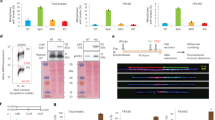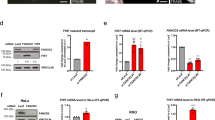Abstract
Common fragile sites are specific regions of the genome that form gaps and breaks on metaphase chromosomes when DNA synthesis is partially inhibited. Fragile sites and their associated genes show frequent deletions and other rearrangements in cancer cells, and may be indicators of DNA replication stress early in tumorigenesis. We have previously shown that the DNA damage response proteins ATR, BRCA1 and FANCD2 play critical roles in maintaining the stability of fragile site regions. To further elucidate the pathways regulating fragile site stability, we have investigated the effects of depletion of the cell cycle checkpoint kinases, CHK1 and CHK2 on common fragile site stability in human cells. We demonstrate that both CHK1 and CHK2 are activated following treatment of cells with low doses of aphidicolin that induce fragile site breakage. Furthermore, we show that depletion of CHK1, but not CHK2, using short-interfering RNA (siRNA) leads to highly destabilized chromosomes and specific common fragile site breakage. In many cells, CHK1 depletion resulted in extensive chromosome fragmentation, which was distinct from endonucleolytic cleavage commonly associated with apoptosis. These findings demonstrate a critical role for the CHK1 kinase in regulating chromosome stability, and in particular, common fragile site stability.
This is a preview of subscription content, access via your institution
Access options
Subscribe to this journal
Receive 50 print issues and online access
$259.00 per year
only $5.18 per issue
Buy this article
- Purchase on Springer Link
- Instant access to full article PDF
Prices may be subject to local taxes which are calculated during checkout





Similar content being viewed by others
References
Abraham RT . (2001). Genes Dev 15: 2177–2196.
Alderton GK, Joenje H, Varon R, Borglum AD, Jeggo PA, O'Driscoll M . (2004). Hum Mol Genet 13: 3127–3138.
Arlt MF, Miller DE, Beer DG, Glover TW . (2002). Genes Chromosomes Cancer 33: 82–92.
Arlt MF, Xu B, Durkin SG, Casper AM, Kastan MB, Glover TW . (2004). Mol Cell Biol 24: 6701–6709.
Bartek J, Lukas J . (2003). Cancer Cell 3: 421–429.
Bartkova J, Horejsi Z, Koed K, Kramer A, Tort F, Zieger K et al. (2005). Am J Hum Genet 75: 654–660.
Casper AM, Nghiem P, Arlt MF, Glover TW . (2002). Cell 111: 779–789.
Casper AM, Durkin SG, Arlt MF, Glover TW . (2004). Am J Hum Genet 4: 456–460.
Fadok VA, Voelker DR, Campbell PA, Cohen JJ, Bratton DL, Henson PM . (1992). J Immunol 148: 2207–2216.
Falck J, Mailand N, Syljuasen RG, Bartek J, Lukas J . (2001). Nature 410: 842–847.
Falck J, Petrini JHJ, Williams BR, Lukas J, Bartek J . (2002). Nat Genet 30: 290–294.
Feijoo C, Hall-Jackson C, Wu R, Jenkins D, Leitch J, Gilbert DM et al. (2001). J Cell Biol 5: 913–923.
Glover TW, Arlt MF, Casper AM, Durkin SG . (2005). Hum Mol Genet 14: R197–R205.
Glover TW, Berger C, Coyle J, Echo B . (1984). Hum Genet 67: 136–142.
Gorgoulis VG, Vassiliou LV, Karakaidos P, Zacharatos P, Kotsinas A, Liloglou T et al. (2005). Nature 434: 907–913.
Hirao A, Cheung A, Duncan G, Girard PM, Elia AJ, Wakeham A et al. (2002). Mol Cell Biol 22: 6521–6532.
Howlett NG, Taniguchi T, Durkin SG, D'Andrea AD, Glover TW . (2005). Hum Mol Genet 14: 693–701.
Huang H, Reed CP, Mordi A, Lomberk G, Wang L, Shridhar V et al. (1999). Genes Chromosomes Cancer 24: 48–55.
Lee SB, Kim SH, Bell DW, Wahrer DC, Schiripo TA, Jorczak MM et al. (2001). Cancer Res 22: 8062–8067.
Le Beau MM, Le Beau MM, Rassool FV, Neilly ME, Espinosa III R, Glover TW et al. (1998). Hum Mol Genet 4: 755–761.
Liu Q, Guntuku S, Cui X-S, Matsuoka S, Cortez D, Tamai K et al. (2000). Genes Dev 14: 1448–1459.
Mailand N, Falck J, Lukas C, Syljuasen RG, Welcker M, Bartek J et al. (2000). Science 288: 1425–1429.
Mailand N, Podtelejnikov AV, Groth A, Mann M, Bartek J, Lukas J . (2002). EMBO J 21: 5911–5920.
Mangelsdorf M, Ried K, Woollatt E, Dayan S, Eyre H, Finnis M et al. (2000). Cancer Res 60: 1683–1689.
Matsuoka S, Rotman G, Ogawa A, Shiloh Y, Tamai K, Elledge SJ . (2000). Proc Natl Acad Sci USA 97: 10389–10394.
Musio A, Montagna C, Mariani T, Tilenni M, Focarelli ML, Brait L et al. (2005). Hum Mol Genet 14: 525–533.
Niida H, Tsuge S, Katsuno Y, Konishi A, Taketa N, Nakanishi M . (2005). J Cell Biol 287: 39246–39252.
Rodriguez R, Meuth M . (2005). Mol Cell Biol [E-pub ahead of print].
Ried K, Finnis M, Hobson L, Mangelsdorf M, Sayan S, Nancarrow JK et al. (2000). Hum Mol Genet 9: 1651–1663.
Schwartz M, Zlotorynski E, Goldberg M, Ozeri E, Rahat A, le Sage C et al. (2005). Genes Dev 19: 2715–2726.
Sorenson CS, Syljuasen RG, Falck J, Schroeder T, Ronnstrand L, Khanna KK et al. (2003). Cancer Cell 3: 247–258.
Syljuasen RG, Sorensen CS, Hansen LT, Fugger K, Lundin C, Johansson F et al. (2005). Mol Cell Biol 25: 3553–3562.
Tait JF, Gibson D . (1992). Arch Biochem Biophys 298: 187–191.
Takai H, Tominaga K, Motoyama N, Minamishima YA, Nagahama H, Tsukiyama T et al. (2000). Genes Dev 14: 1439–1447.
Wilke CM, Hall BK, Hoge A, Paradee W, Smith DI, Glover TW . (1996). Hum Mol Genet 5: 187–195.
Xu B, Kim ST, Kastan MB . (2001). Mol Cell Biol 21: 3445–3450.
Yarden RI, Pardo-Reoyo S, Sgagias M, Cowan KH, Brody LC . (2002). Nat Genet 30: 285–289.
Zachos G, Rainey MD, Gillespie DA . (2003). EMBO J 22: 713–723.
Zachos G, Rainey MD, Gillespie DA . (2005). Mol Cell Biol 25: 563–574.
Zhang YW, Otterness DM, Chiang GG, Xie W, Liu YC, Mercurio F et al. (2005). Mol Cell 19: 607–618.
Zou L, Elledge SJ . (2003). Science 300: 1542–1548.
Acknowledgements
We thank Sara Hamon and Mats Ljungman for technical assistance as well as David Ferguson, Chris Canman, Ryan Ragland, and Susan Dagenais for helpful discussions and thoughtful comments. This study was supported by NIH Grants CA 43222 (TWG) and 5 T32 GMO 7544 (SGD). NGH is the recipient of a Leukemia Research Foundation Postdoctoral Fellowship.
Author information
Authors and Affiliations
Corresponding author
Additional information
Supplementary Information accompanies the paper on Oncogene website (http://www.nature.com/onc).
Rights and permissions
About this article
Cite this article
Durkin, S., Arlt, M., Howlett, N. et al. Depletion of CHK1, but not CHK2, induces chromosomal instability and breaks at common fragile sites. Oncogene 25, 4381–4388 (2006). https://doi.org/10.1038/sj.onc.1209466
Received:
Revised:
Accepted:
Published:
Issue Date:
DOI: https://doi.org/10.1038/sj.onc.1209466
Keywords
This article is cited by
-
Common fragile sites: protection and repair
Cell & Bioscience (2020)
-
Genome-wide high-resolution mapping of mitotic DNA synthesis sites and common fragile sites by direct sequencing
Cell Research (2020)
-
Mutations in DONSON disrupt replication fork stability and cause microcephalic dwarfism
Nature Genetics (2017)
-
Interplay between genetic and epigenetic factors governs common fragile site instability in cancer
Cellular and Molecular Life Sciences (2014)
-
Replication fork recovery and regulation of common fragile sites stability
Cellular and Molecular Life Sciences (2014)



